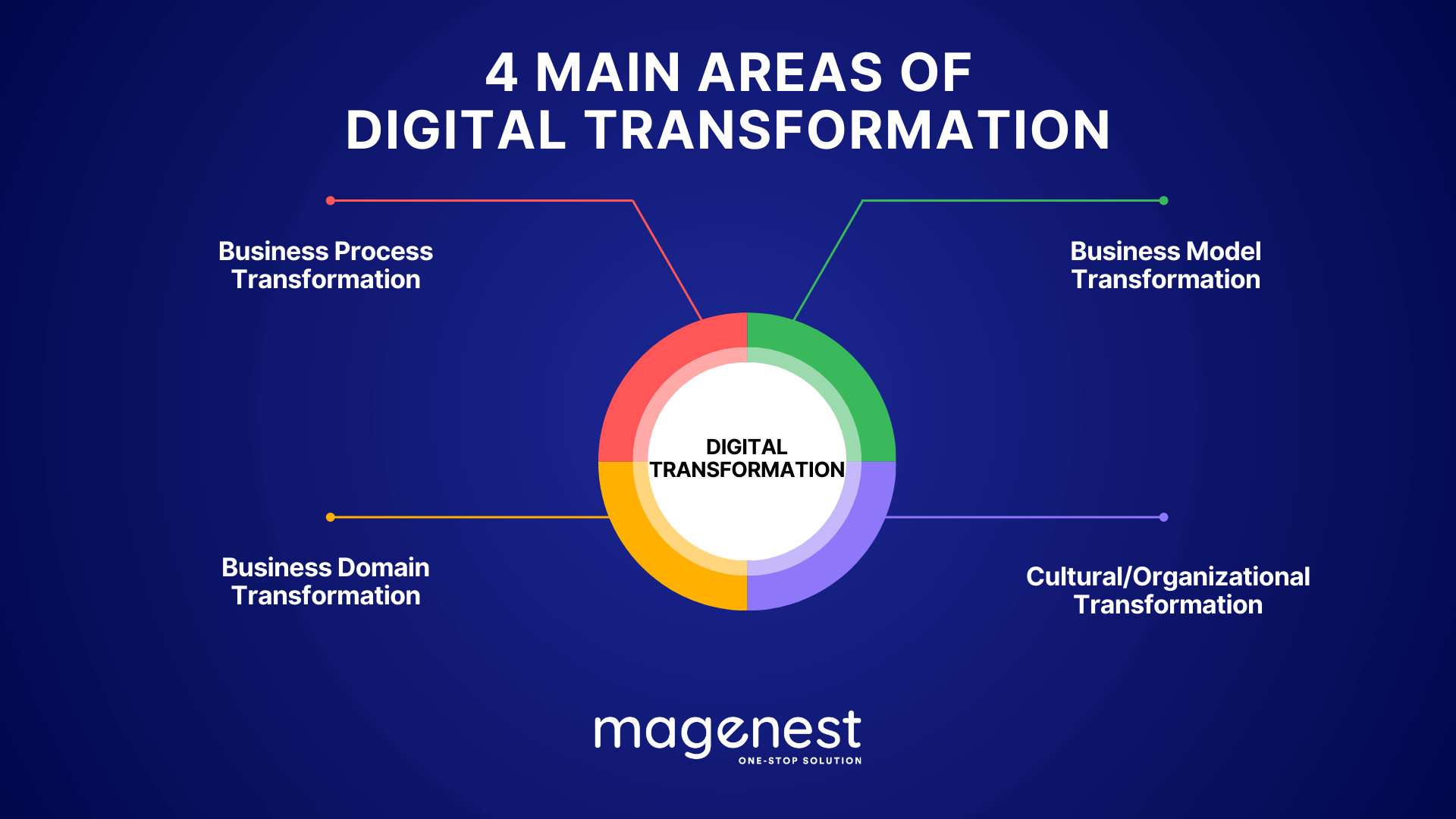In today’s world, technology will generally do one of two things: expose opportunities for success or threaten organizations that refuse to accept changing ways in the business landscape. If you are looking to digitally transform your business? If so, there are 4 main areas of digital transformation you should focus on.
In this blog post, we’ll outline digital transformation focus areas and discuss what they mean, how they can impact your business as well as some challenges of this trend. Stay ahead of the curve and make sure you’re ready for digital transformation!
Table of Contents
What Is Digital Transformation?
Digital transformation is the process of using digital technologies to create new or improved business processes, products, and services. This can involve everything from automating manual processes to creating entirely new customer experiences and meeting the KPI of digital transformation.

The integration of new digital technologies is not always easy, but it can have a major impact on how businesses operate. Businesses need to become comfortable with the uncomfortable and experimental – knowing failure might be possible in order for these changes to succeed.
What Are the 4 Main Areas of Digital Transformation?
Transformation is a big word that can mean different things to varying degrees. For some, transformation may be as easy and straightforward while others might find themselves overwhelmed with the process.

When looking into some ways to transform your business, there are four main types of digital transformations that we recommend taking advantage of:
Process Transformation
In today’s world of digital transformation, it refers to the process by which a company aims at transforming its business processes with technology in order for them to be able to use their skills and successes as well as opportunities more efficiently.
Process transformation involves using digital technologies to automate or improve existing business processes. This can include anything from automating data entry to implementing artificial intelligence to streamline decision-making.
By transforming processes, organizations aim to reduce costs, speed up operations, and enhance the quality of their products or services. For example, introducing robotic process automation may convert manual operations found in procurement, supply chain management, and other administrative functions.
Business Model Transformation
The business world is changing at an exponential rate, and companies are realizing that they need to change with it. Business model transformation focuses on finite areas of the business while reinvention or digital transformations aim deeper into how value gets delivered in order for their industry’s model.
The Netflix model is a great example of how business transformation can be achieved through the use of technology. It started out as an offline service that delivered DVDs to customers’ homes but ended up transforming into one where users stream videos on demand from their computer screen or mobile device instead. The key to success is not always in the specifics of your business model, but rather in how well you can adapt and innovate.
By innovating and expanding upon their existing success models, corporations can undergo a transformation that unlocks substantial new growth opportunities. This is a compelling reason for more companies to pursue a similar trajectory of evolution.
Domain Transformation
The current domain transformation market is one of the most significant opportunities for company growth. When one company is able to effectively transition into another industry, this is known as a domain transformation.
Amazon, for example, has expanded its offerings to include both its own streaming platform (Amazon Prime) and Amazon Web Services (AWS), which is now the most widely used cloud computing and infrastructure provider. Amazon was able to make significant progress when it entered both of these new-to-the-company businesses because it had the financial resources to do so. Previously, each of these fields was controlled by large companies in their respective regions such as Microsoft or IBM.
Amazon’s foray into cloud services, though initially unexpected, was a strategic utilization of its existing capabilities. The company had already built extensive storage infrastructure to support its global operations. This infrastructure, coupled with its computing services and hosting solutions for startups and businesses within the Amazon ecosystem, laid the groundwork for its entry into the cloud sector. What was needed was the vision and confidence to transition these capabilities into a new domain.
Businesses undergoing digital transformation should be equally attentive to the potential for domain transformation. The integration of new technologies often reveals novel opportunities for expanding or pivoting their business model into new realms.
Cultural/Organizational Transformation
The journey to creating a comprehensive and cohesive brand experience can be challenging, but it will ultimately lead you down the path of delivering an overall better outcome for your customers. Cultural/organizational transformation involves changing the mindset, attitudes, and behaviors of an organization’s workforce to embrace digital innovation. It requires fostering a culture of continuous learning, adaptability, and collaboration.
Experian is a great example of cultural/organizational transformation. They were able to change their workflow and focus on data by instilling collaboration into the system, which in turn made employees more agile with how they do things internally at every level throughout all departments as well as providing them an opportunity for professional growth through learning new skills.
This area of digital transformation is crucial for the success of other transformation efforts, as it deals with people and organizational norms. Initiatives might include digital literacy programs, collaborative working environments, and a shift from hierarchical to more agile, team-based structures.
Why Does a Company Need Digital Transformation?
Digital transformation is not an easy process, but it is one that is essential for companies that want to stay ahead of the curve. It requires a complete overhaul of the way a company does business, from the ground up. Every aspect of the company must be examined and updated in order to keep up with the times.

In fact, Digital transformation allows companies to take advantage of new opportunities and grow their businesses. The benefits of digital transformation far outweigh the costs. Companies that undergo digital transformation are more likely to succeed in the long run. They will be better equipped to deal with changes in the market and will be able to better serve their customers. Here are some key reasons why a company needs digital transformation:
- Competitive Advantage: Digital transformation helps companies stay competitive in an increasingly digital world. By adopting new technologies and digital practices, businesses can innovate faster, create more efficient processes, and deliver better customer experiences, which are vital for staying ahead of competitors.
- Customer Expectations: Today’s consumers expect a seamless, digital-first interaction with companies. Digital transformation enables businesses to meet these expectations by leveraging technologies like AI, mobile platforms, and personalized online experiences, thereby enhancing customer satisfaction and loyalty.
- Operational Efficiency: Transforming digital processes leads to increased efficiency in operations. Automation of manual tasks, improved data management, and streamlined workflows reduce costs and time expenditure, allowing employees to focus on more strategic, value-adding activities.
- Data-Driven Decision-Making: Digital transformation allows companies to gather and analyze large amounts of data. This data-driven approach aids in making more informed decisions, predicting market trends, understanding customer preferences, and identifying new opportunities.
- Innovation and Adaptability: Embracing digital transformation encourages a culture of innovation and adaptability within the organization. It fosters an environment where experimenting with new ideas and technologies is encouraged, which is crucial for long-term growth and relevance.
- Sustainability: Digital processes often lead to more sustainable business practices by reducing the need for physical materials and optimizing resource usage, which is increasingly important to both consumers and regulatory bodies.
Top Digital Transformation Challenges Impacting Businesses in 2024
Lack of Skilled Workforce
One of the biggest challenges facing businesses is the lack of a skilled workforce. With the rapid pace of change, it’s difficult to keep up with the demand for new skills. According to a survey conducted on businesses, 54% of firms have said that they are unable to achieve their digital transformation goals as a result of a shortage of technically skilled individuals in their workforce.

To ensure the success of digital transformation initiatives, it’s vital to have expertise in key areas such as enterprise architecture, cybersecurity, cloud computing, analytics, and digital experience design. Moreover, fostering digital agility across the entire organization is critical for enhancing readiness for change.
Outsourcing this work to external consultants and digital transformation experts might be a solution and assist organizations who are lacking in IT personnel battling this difficulty and bridge the implementation and migration gap.
Lack of Data
Another big challenge facing businesses is the lack of data. In order to make informed decisions about digital transformation, businesses need data. However, many companies don’t have the data they need to make these decisions. This is often due to a lack of data governance or a siloed approach to data management.

The greatest risk for a digital transformation project is not knowing where you stand. You need to answer all of these questions before starting: What areas do we want upgrades in? Which processes aren’t working well and why isn’t this area functioning optimally as it currently stands?
Budget Constraints
The cost of digital transformation is not something that should be taken lightly. Even if an organization has a poor strategy for implementing it, scope creep can still bring new expenses that drive up the overall price tag of this project. This is often due to a lack of understanding of the ROI of digital transformation or a belief that it’s not worth the investment.

Have a clear understanding of what your long-term goals are, as well as the return on investment (ROI) you want to accomplish as a result of your transformation process. You will have a lot better understanding of what kinds of expenditures are excessive and where you have the flexibility to make adjustments to your budget as a result of doing this.
Security Concerns
Security is a major concern for businesses when it comes to digital transformation. With so much data being collected and stored online, there’s a greater risk of it being hacked or stolen. This can lead to a loss of customer trust and confidence in the company.

Be sure to have a plan ready to put into action to proactively deal with these dangers before they materialize. Take the advice of a cybersecurity specialist to assist you in finding any holes in your system’s protection
The Continuous Evolution of Customer Needs
The process of digital transformation is not a simple one, and it may take many years to complete extensive transformation activities. With the rapid pace of change, customers’ needs and expectations are constantly changing. This can be difficult to keep up with, and it can lead to frustration among customers who feel that their needs are not being met. Ensure you’re prepared to adapt to new digital technologies and don’t get caught off guard when the time comes.
Tips for a Successful Digital Transformation
Successful digital transformation requires a well-thought-out strategy and careful execution. Here are some tips to guide this process.
Modernizing Technology Infrastructure
To support a successful digital transformation, it’s crucial to upgrade and modernize your company’s technology infrastructure. Embracing cloud-based solutions is key to achieving agility and scalability. The integration of emerging technologies such as the Internet of Things (IoT) and Artificial Intelligence (AI) can significantly enhance your operational capabilities.

Additionally, leveraging data analytics is vital for making informed decisions. A contemporary infrastructure is foundational for ensuring adaptability, managing increased data volumes efficiently, and providing seamless digital experiences to users.
Develop a Skilled Workforce
Achieving a successful digital transformation hinges on effective change management and workforce engagement. It’s crucial to actively involve employees in the transformation process, providing them with the necessary training and support. This approach helps in fostering a culture that is open to change. By engaging the workforce, you can minimize resistance and ensure a smoother transition to new technologies and processes.
Focus on Customer Experience and Security
A successful digital transformation should prioritize enhancing the customer experience. Utilize digital tools to enrich customer interactions, tailor services to individual needs, and address the evolving expectations of your customer base.

Equally important is the safeguarding of customer data and privacy. Implement robust data protection measures, ensure secure storage and transmission of information, and maintain transparency about your data practices. By respecting privacy and prioritizing security, you build trust and foster customer loyalty, which are essential in today’s digital landscape.
Cultivate a Digital Culture
To drive a successful digital transformation, it’s imperative to foster a culture that is receptive to change, champions innovation, and values continuous learning. This cultural shift is crucial for embracing new technologies and methodologies effectively.
Actively seeking customer feedback, staying attuned to market trends, and embracing emerging technologies are essential practices. Regularly refining strategies to adapt to shifting customer expectations and market dynamics can open up new avenues for growth and innovation. This approach not only facilitates adaptation but also ensures that the organization remains at the forefront of digital evolution.
Monitor Progress and Adapt
For a digital transformation to be successful, it is critical to continuously monitor its progress and be prepared to adapt strategies when needed. This process should include openness to feedback, learning from any setbacks, and committing to ongoing, iterative improvements.
Using well-defined Key Performance Indicators (KPIs) is essential for measuring the success of your digital transformation initiatives. Regularly track progress, evaluate the effectiveness of your strategies, and make adjustments based on data-driven insights. This approach ensures that the transformation not only meets its intended goals but also delivers tangible business value.
In Conclusion
The need for digital transformation is universal, but the specifics vary depending on your industry and specific challenges. No matter what you’re trying to achieve with new technologies like artificial intelligence (AI) or what main areas of digital transformation you want to join in, Magenest will help you to overcome them and achieve true transformation with successful results on all sides of a transaction. Contact us today to expand your business in today’s digital economy.











